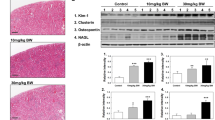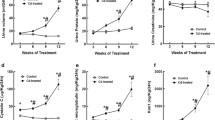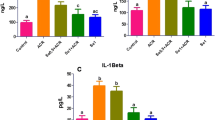Abstract
The intranephron distribution of two major cysteine S-conjugate β-lyases was determined in order to clarify the role of these enzymes in promoting the nephrotoxicity associated with certain halogenated xenobiotics. Various nephron segments [i.e., glomerulus, early, middle, and terminal portions of the proximal tubule (S1, S2, and S3 respectively), the thick ascending limb, the distal tubule, and the collecting tubule] were isolated by microdissection from collagenase-treated rat kidneys. Each segment was dissected in Hanks' solution, solubilized with Triton X-100, and applied to a micropolyacrylamide gel constructed with a continuous gradient. The gels were subjected to electrophoresis and then incubated in the dark in a solution containing S-(1,2 dichlorovinyl)-l-cysteine (DCVC), sodium α-keto-γ-methiolbutyrate, phenazine methosulfate, and nitroblue tetrazolium. The position of cysteine S-conjugate β-lyase- and l-amino acid oxidase activities in the gels was revealed by the presence of blue formazen dye bands. The relative intensities of the bands were determined by optical scanning with a microdensitometer. Three bands were detected: band I (Mr ˜ 330 000) corresponds to a recently described high Mr cysteine S-conjugate β-lyase whereas band III (Mr ˜ 90 000) corresponds to a lower Mr cysteine S-conjugate β-lyase (identical to cytosolic glutamine transaminase K). Band II (Mr ˜ 240 000) corresponds to l-amino acid oxidase (a unique activity of the B isoform of rat kidney l-hydroxy acid oxidase). β-Lyase activity with DCVC as substrate was detected in the S1, S2, and S3 segments of the nephron but not in other regions of the kidney. The activity was in the order: S2 = S3 > S1. In another series of experiments, rats were killed 24 h after treatment with hexachloro- 1,3-butadiene (HCBD). In whole kidney homogenates the relative intensity of band III (per 22.2 μg tissue wet weight) after a 30 min incubation was induced significantly (by 50%), but the relative intensities of the other two bands were unchanged. On the other hand, in proximal tubules isolated from HCBD-treated rats the relative intensities (per 5 mm of nephron) of peak I of S2, peak II of S3, and peak III of S3 were significantly reduced by 28, 33, and 72%, respectively. These findings suggest that the low Mrβ-lyase is induced by HCBD and that impaired cell function in the segments (especially S3) results in proteins leaking out of the target cells. To examine the relationship between the nephrotoxic effect of HCBD and cysteine S-conjugate β-lyase activity, the intracellular ATP:protein ratio was quantitated in each nephron segment and in whole kidney homogenates. In HCBD-treated rats the ATP:protein ratio of the S1, S2, and S3 segments was unchanged, decreased by ˜50%, and increased by ˜30%, respectively. In the kidney homogenates of HCBD-treated rats the ATP content was decreased by 32%. However, the loss of ATP was significantly less when the rats were pretreated with aminooxyacetate (a general inhibitor of pyridoxal 5′-phosphate-dependent enzymes, including β-lyase) 1 h before HCBD administration. The results strongly suggest that HCBD is converted to toxic metabolites within the kidney and that this process leads to metabolic derangement and reduction of ATP in susceptible kidney cells.
Similar content being viewed by others
Author information
Authors and Affiliations
Additional information
Received: 16 April 1996 / Accepted: 16 July 1996
Rights and permissions
About this article
Cite this article
Kim, H., Cha, S., Abraham, D. et al. Intranephron distribution of cysteine S -conjugate β-lyase activity and its implication for hexachloro-1,3-butadiene-induced nephrotoxicity in rats. Arch Toxicol 71, 131–141 (1997). https://doi.org/10.1007/s002040050367
Issue Date:
DOI: https://doi.org/10.1007/s002040050367




